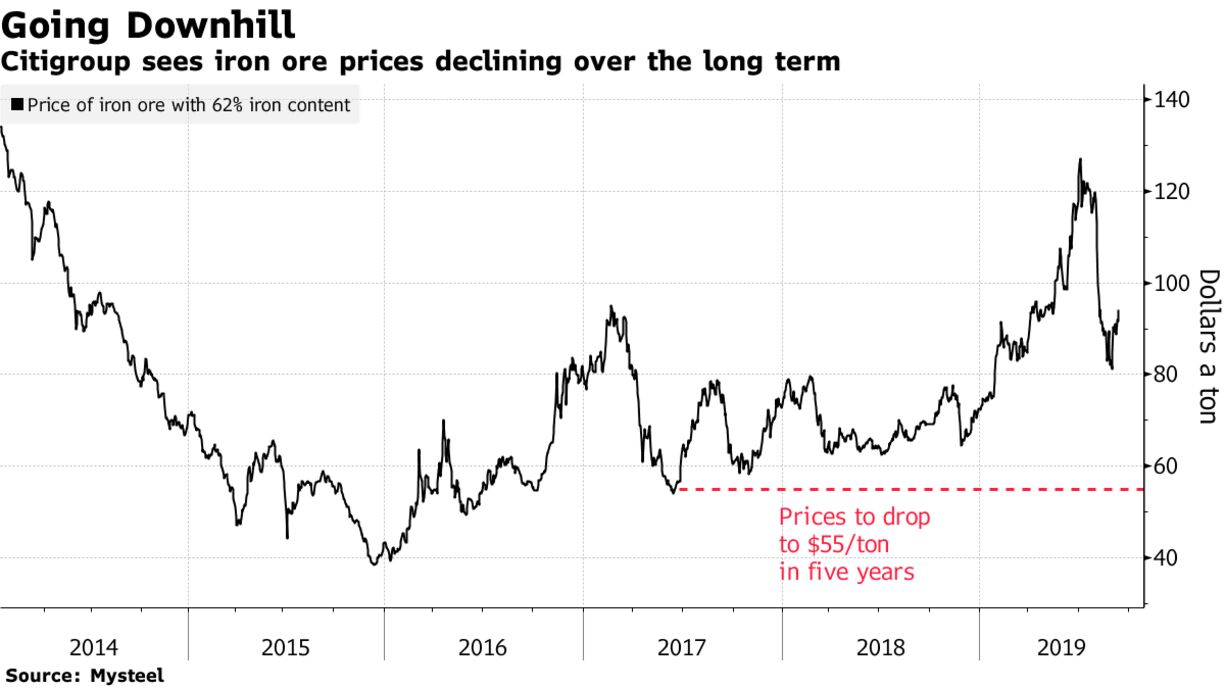By Krystal ChiaSeptember 11, 2019, 6:26 PM GMT-7Updated on September 12, 2019, 12:26 AM GMT-7
Iron ore faces a long, slow slide over the coming half-decade. Prices are poised to decline over the long term as the impact of weakening demand in biggest buyer China will more than offset gains in consumption seen in other emerging markets including India, according to Citigroup Inc.
“Steel demand is no longer going to be what it was,” Ed Morse, global head of commodity research, said in an interview. “No combination of India, Brazil and any other emerging-market country, no matter how big, is going to replace what China did alone,” he said, referring to spike in demand from the nation’s “fixed-asset investment extravaganza,” between the 1990s to 2010.

Iron ore’s fortunes — and those of the top miners in Australia and Brazil, including Vale SA and Fortescue Metals Group Ltd. — largely turn on the strength and trajectory of demand in China, which buys about 70% of seaborne cargoes. As Asia’s top economy slows and the government steers growth away from infrastructure and heavy industry to consumers, steel demand is expected to flatten, then ease, although there’s no consensus on the timing of the shift.
“We have been long-term bearish iron ore,” Morse said in Singapore. “It’s a combination of unbelievably cheap, new raw material from Australia and Brazil, and a dampening of demand at the same time.”
Benchmark prices will end this year at the mid-$90s a ton, before falling to $75 at the end of 2020, he said. Five years out, they are seen at $55 a ton — a level that’s still well above current costs of production at the largest miners. Spot ore was last at $94.10 a ton, up 30% in 2019, according to Mysteel Global.
Top Player
At present, China dominates the global steel industry, even as output in India has been expanding at a rapid clip. In July, mainland mills pumped out 85.2 million tons of crude steel, or 54% of the worldwide total. Second-placed India made 9.2 million tons, or 5.9%. Brazil placed ninth, making 2.4 million.
BHP Group, the world’s largest miner, said last month its base case is that Chinese steel production “has entered a plateau phase, with the literal peak to occur no later than the middle of next decade.”
In its latest quarterly outlook, the Australian government said China’s steel output is expected to decline gradually, hurt by moderating consumption, more stringent environmental curbs and reductions in mill capacity. Production will ease to 926 million tons in 2021 from 940 million this year, it said.
On Thursday, iron ore futures pushed back into the mid-$90s in Singapore, rallying as much as 4.3% to $94.83 a ton. The gains came as steel futures climbed, with U.S.-China trade tensions easing and mainland mill curbs crimping output ahead of a key national break.
— With assistance by Ranjeetha Pakiam





















